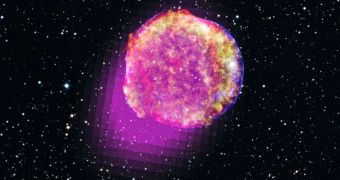Astronomers using the NASA Fermi Gamma-ray Space Telescope say that the remnants of the cosmic object known as Tycho's supernova have recently been imaged in high-energy gamma-rays. They say that the structure is extremely active in this region of the electromagnetic spectrum.
The supernova first appeared as another star in the sky in early November 1572, and was extensively studied by the great Danish astronomer Tycho Brahe, after whom it was eventually named. Though the object became invisible to the eye, its remnant is still there, continuously expanding across space.
Astrophysicists are interested in this study too, since Fermi could potentially uncover more details on the origins of proton fluxes called cosmic rays, which fly through deep-space very close to the speed of light. Experts have been trying to figure out what produces these radiations for many years.
One of the most intriguing aspects of cosmic rays is that they become tremendously energetic as they travel through space. How this happens is still a mystery, although a number of theories has been proposed to explain the occurrence.
The leading explanation is that electromagnetic fields around their points of origins act like giant particle accelerators, increasing their energies until the particles reach 99.9 percent the speed of light.
“Fortunately, high-energy gamma rays are produced when cosmic rays strike interstellar gas and starlight. These gamma rays come to Fermi straight from their sources,” Francesco Giordano explains.
The expert, who holds joint appointments, at the University of Bari and the National Institute of Nuclear Physics, both in Italy, was also the lead author of a new paper describing the Fermi study. The work is published in the December 7 issue of the Astrophysical Journal Letters.
Experts used the Large Area Telescope (LAT) aboard Fermi to look at Tycho's supernova because the structure is still extremely young in astronomical terms. This is important because younger remnants produce a lot more gamma-rays than older ones. “This detection gives us another piece of evidence supporting the notion that supernova remnants can accelerate cosmic rays,” Kavli Institute for Particle Astrophysics and Cosmology (KIPAC) astrophysicist and study coauthor Stefan Funk explains.

 14 DAY TRIAL //
14 DAY TRIAL //